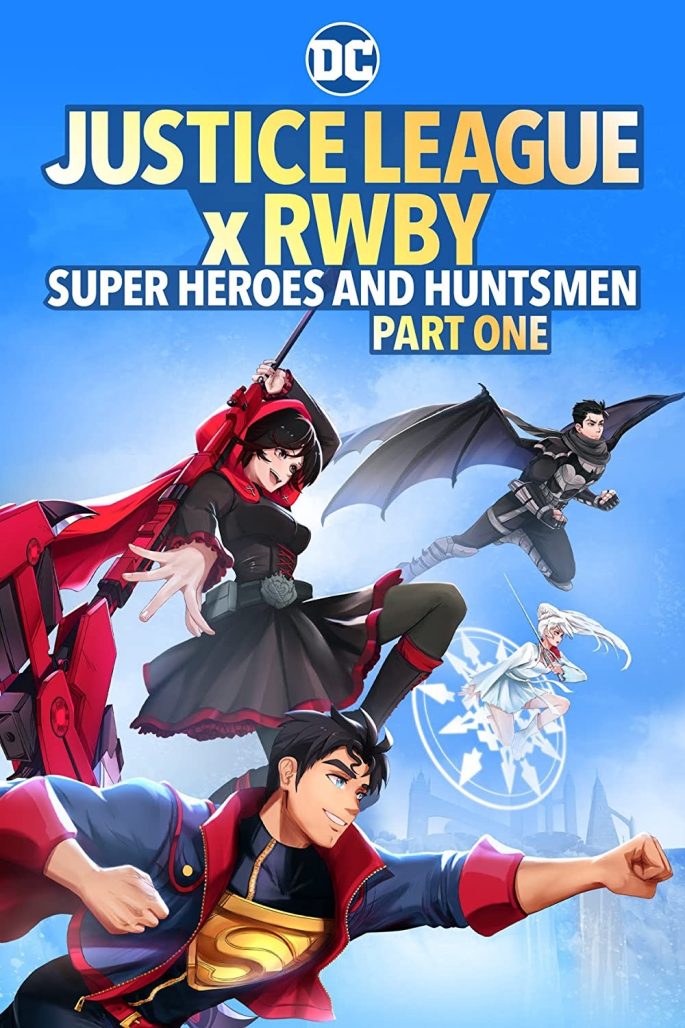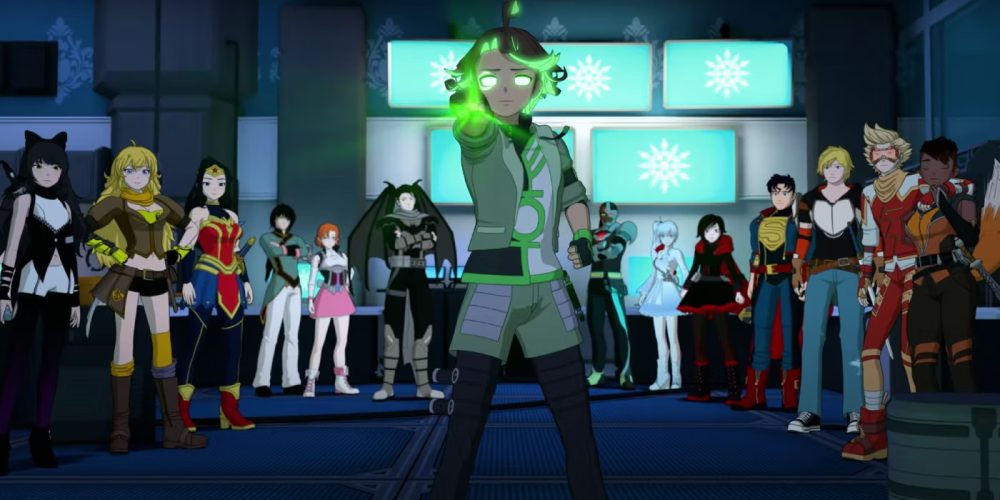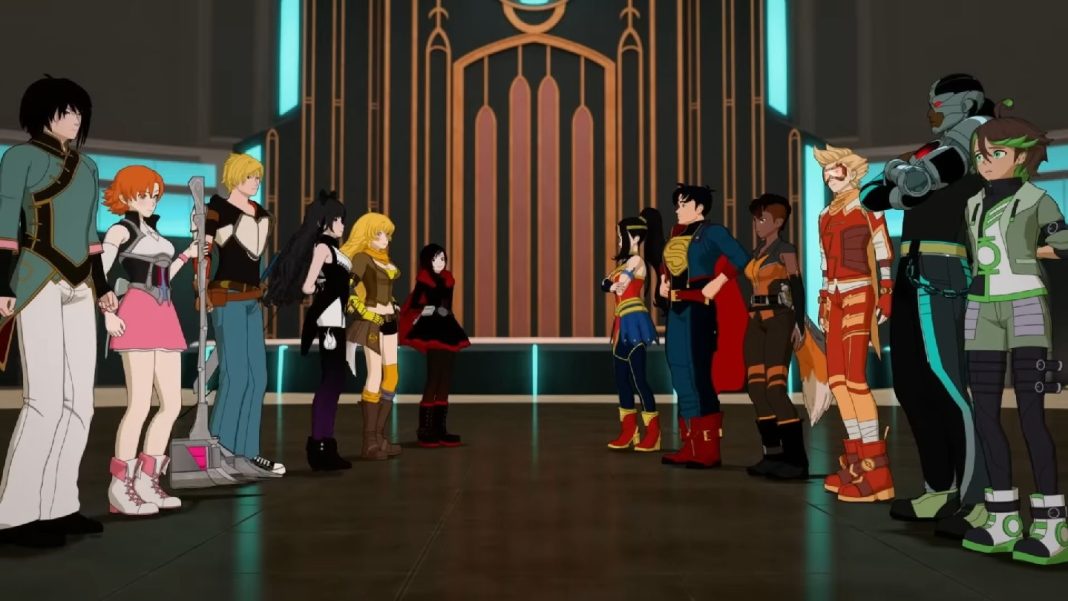Created by Monty Oum, RWBY is an American anime-influenced computer-animated web series from media company Rooster Teeth. The franchise about a group of young heroes in the future-fantasy world of Remnant training battle the evils of the world quickly became a fan-favorite when it debuted almost a decade ago. In fact, the finale of RWBY Volume 9 just premiered last weekend. And while Volume 10 won’t be released until September, Rooster Teeth has fans covered with the all-new Justice League x RWBY: Super Heroes & Huntsmen, Part One crossover animated movie.

Ahead of the film’s release, we had the pleasure of interviewing the film’s screenwriter Meghan Fitzmartin as well as producer/director Kerry Shawcross about their work on the Justice League x RWBY animated film.
Taimur Dar: I know from the panel for Justice League x RWBY premiere at WonderCon, you admitted you went into the project knowing very little about the RWBY franchise. I’m in the same bucket. I can’t help but be reminded of that first episode of Ted Lasso when he demonstrates his lack of soccer knowledge at his press conference. How did you approach this project as a writer?
Meghan Fitzmartin: I came from a place wanting and knowing I would be a fan of this. That is how I approach everything in life. I like to be an enthusiastic fan. I absolutely loved RWBY when I fully binged it. I got very emotionally invested and I was able to come to the table with a lot of stuff. The joy was also being able to work on this at the same time that they were working on Volume 9 and going, “What’s going to happen because I need to know this for the movie!” I’m also now a deep fan and I care a lot about these characters.

Fitzmartin: I work in the comics space as well as animation. Being able to look at it and see what worked for specifically comics and what may not work for animation and vice versa was very important to me. Those mediums are so incredibly important and special to me. I went in with a sense of what I could take that pulls from the heart of what is already there and what can I create that works better for animation that they couldn’t do in the comics.
Dar: In any work of fiction, I despise hearing the phrase, “As you know.” It’s an incredibly lazy way to convey exposition. One of my favorite comic writers unfortunately used it in a book a few months ago and I winced.
Fitzmartin: Oh!!!
Dar: Exactly! Because of the nature of the story with the Justice League as the audience surrogate transported to a new world, does that make it easier and more natural in conveying exposition?
Fitzmartin: Oh, hell yeah! Part of the reason of creating these characters in this tumultuous world is to give them this sense of dissonance and needing to play catchup in the same way that we wanted the audience to do the same. I’m a firm believer that your audience is as clever as you are, oftentimes more clever than I am. [I wanted] to honor that and not beat around the bush. We’re all trying to figure it out while these characters are learning a world they’ve not been in before as I’m sure a lot of the viewers. It gave us a nice arena to play in.

Fitzmartin: I love that you’re using a lot of Ted Lasso comparisons! I love Ted Lasso and at this point I would die for the entire Richmond team because I love every single one of those players. It’s a really good example of when you’re dealing with an ensemble. I love working in ensembles and character dynamics. That to me provides these very beautiful character pieces and moments. I also have worked in smaller casts too. They both have their pros and cons. But the joy of having a larger cast and a larger team is you get to have these really special moments. Part of it is also the joy of looking for the surprise moments of who’s going to connect. We pair everybody together intentionally, but even so there are moments I didn’t realize one character was going to feel a way about a certain character and that they were going to have a sweet line or moment. You do that by remembering that these characters are people. That’s the thing that Ted Lasso does well. You remember the different characters and players because there’s a piece of each character that makes them more human to you. That’s what we tried to do in Justice League x RWBY.
Dar: I won’t say too much as to avoid spoilers, but I couldn’t help but notice some overlapping themes between the Justice League x RWBY animated film and the Dark Crisis: Young Justice comic miniseries you wrote, specifically the idea of simulated realities. I’m curious if one project influenced the other.
Fitzmartin: Honestly, what most likely inspired both of them was a sense of being in the pandemic and feeling like I was in sort of a simulation. Both projects were me grappling with that and not being able to move. A lot of things were at play during a very particular strange time in life that ended up inspiring these projects.
Dar: I know the production of this Justice League x RWBY animated film was done simultaneously with RWBY Volume 9 which will have just concluded by the time the film is available. Working on both the main animated series in addition to an animated film is always challenging, which likely explains the longer gap between Volume 8 and 9. How was the workload and your experience?
Kerry Shawcross: The production team and everybody in general did a really good job. We’ve gone out of our way to be a studio that does not “crunch.” I’m not going to say I didn’t have some busier days than normal. I certainly was not having to do anything crazier. Because we do everything in house from the storyboard and recording process all the way to the end, there was always a team that was able to work on something. One of the reasons I took the first movie besides just wanting to do it was so the other episode directors could just focus on Volume 9. We did our best to distribute things around so no person was too swamped. The final episode of Volume 9 premieres this weekend and then the movie comes out just a few days after. It’s all happening at once which is just perfect.
Dar: It’s fair to say there’s an overlap between anime and comic fandom. Superheroes, particularly those of DC Comics, have saturated the culture. Are you a DC Comics reader yourself?
Shawcross: Not religiously. I’ve gone through phases. Growing up I was really into Batman: The Animated Series and Batman Beyond and the Justice League cartoon. I’m not going to lie and say I’ve been keeping up, which is why I’m glad Meghan worked on this and helped us out with that side. It was a really good way to pull these universes together and work together on it versus us taking a stabbing on it on our own. Of course, I’m a huge fan of these characters.
Dar: On the publishing side, RWBY and the Justice League have crossed over in comics. I can definitely see that the character designs of Mirka Andolfo from the first RWBY/Justice League miniseries influenced some of the designs in the film. How did you approach the character designs in the film?
Shawcross: We did the comics a bit ago and there’s a new run going now. So, when we decided to do these movies we knew we weren’t going to adapt the same stories but we were going to play with some of the ideas. We started by looking at some of the designs that the comics had done which we thought were great. Some of them adapted a lot closer and others we tried to be a little more animation friendly. Ultimately, the comics did a great job and our team at Rooster Teeth also did a great job taking these characters and running them through a RWBY world filter. It was a lot of fun to do. We had a pretty open rein on what we were allowed to do.
Dar: Steven Spielberg has talked in past interviews about an encounter he had with John Ford, which he hilariously depicted in his last film The Fabelmans, and the piece of advice he received where to put the horizon line. Obviously, it’s not a hard and fast rule, but I’m curious as a filmmaker do you subscribe to any artistic dogma yourself?
Shawcross: That’s assuming I know what I’m doing, which is a big assumption, but I appreciate it!
Dar: [Laughs]
Shawcross: For me the thing I always try to keep in mind the most, and this is going to sound really simple, is the characters. When I watch things, even though I’m engaged in the plot, I’m much more invested in the characters. RWBY, especially in this movie, is really big on injecting either humor or human moments into these characters as early as possible. For me the plot is important but the characters are what’s going to make people fall in love with something.
Dar: Was the plan always to produce two films?
Shawcross: I think from the get-go the thought was let’s make two of these. There were talks about how connected they would be. Pretty early on we decided that we wanted to do this two-part story. What’s nice about them is that individually they are all-encompassing and complete stories. But at the end of it when they’re [watched] together, they’re going to seem that much bigger.
Dar: Screenwriter Meghan Fitzmartin mentioned how living during the pandemic lockdown influenced the story, specifically the idea of living in a simulated reality. I’m curious if that was the case for you as the director.
Shawcross: I think for years we’re all going to be still figuring out how the pandemic affected us and discovering new things about it. It was definitely interesting to be working on a film that involves simulated reality while we were all working on it remotely. It may have been a little more subconscious, but there was this [desire] to bring these characters together in a way that we couldn’t bring ourselves together as cheesy as that might sound. It’s still mindboggling to me that we were able to make this during the pandemic but I’m really proud of the team for doing it.
Dar: Finally, what can you tease or excite fans for Part 2?
Shawcross: I will say that it’s pretty cool to see the DC Justice League characters in Remnant and I wonder what’s next!
Justice League x RWBY: Super Heroes & Huntsmen, Part One is available Digitally and on 4K Ultra HD Blu-ray Combo Pack and Blu-ray tomorrow on April 25, 2023.
Be sure to check out The Beat‘s WonderCon video interviews with the Justice League x RWBY voice cast including the Justice League voice actors David Errigo Jr. (The Flash), Jeannie Tirado (Green Lantern), Natalie Alyn Lind (Wonder Woman) and Tru Valentino as well as the RWBY voice performers consisting of Lindsay Jones (Ruby Rose), Kara Eberle (Weiss Schnee), Arryn Zech (Blake Belladonna) and Barbara Dunkelman (Yang Xiao Long).









